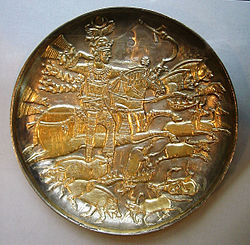- Collectable plate from World War I-era France, featuring portraits of Poincaré, George V, Nicholas II and Albert I.
- Christmas 1937 plate by Königliche Porzellan Manufaktur , Berlin



A plate is a broad, mainly flat vessel on which food can be served. [1] A plate can also be used for ceremonial or decorative purposes. Most plates are circular, but they may be any shape, or made of any water-resistant material. Generally plates are raised round the edges, either by a curving up, or a wider lip or raised portion. Vessels with no lip, especially if they have a more rounded profile, are likely to be considered as bowls or dishes, as are very large vessels with a plate shape. Plates are dishware, and tableware. Plates in wood, pottery and metal go back into antiquity in many cultures.
Contents

In Western culture and many other cultures, the plate is the typical vessel from which food is eaten and on which it is served, provided the food is not too high in liquid content, its primary alternative is the bowl. Some South Asian and Southeast Asian cultures use leaf plates made from the leaves of a variety of plants, including the banana leaf, pandan leaf, sometimes using underlying paper. [2] Parts of the bamboo plant, like sections of bamboo tubes , bambuseae leaves, bamboo shoot skin [3] , and the paper (cf. Kaishi and Washi) are also used as plates in East Asian cultures.














